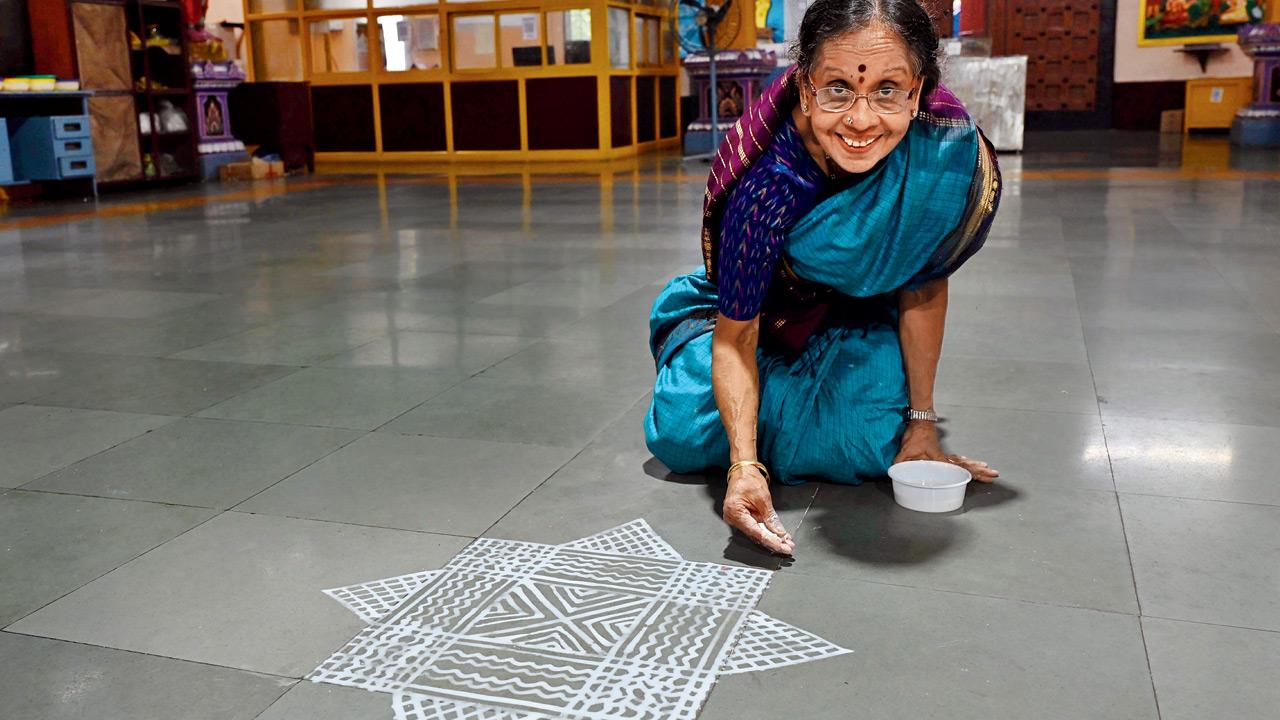Kolam, once a part of every Tamilian home daily morning routine, has become a rarity that occurs around festivals or happy occasions. For a few, though, here’s how it still holds a special place in their day

Kamala Viswanathan has been drawing kolams every day for the last 35 years. PIC/Kirti Surve Parade
Kolam is where art intersects with mathematical precision. The geometric patterns serve not only a devotional purpose but also act as a form of therapeutic activity for those who still indulge in the practice. The art is handed down to the generations of Tamil Mumbaikars and is considered a ritual of acknowledgement and appreciation. The geometric patterns are made with a rice flour mixture outside one’s household, typically in South India.
In Tamil Nadu, kolams are a regular sight outside thresholds, especially in the month of Margazai (December 15 to January 15) during which the women sprinkle cow-dung-infused water outside their doorstep — cow dung is an easily accessible natural antiseptic — after which they proceed to begin drawing it. Known for its versatility, kolams are made with either dry rice flour (podi) or its paste (maavu); the former is used if it’s only for a day and the latter can last up to three to four days. While many might use “kolam” and “rangoli” interchangeably, what sets a kolam apart is the sustainability if maavu is used. In tune with the cultures intrinsic tenants of peaceful co-existence with other living beings, the rice flour nourishes for ants, birds, and squirrels.
As this skill diffuses from generation to generation, many of its intricate details get lost along the way. We visit Matunga, which is still considered a stronghold of the Tamil community to meet Kamala Viswanathan, a 73-year-old who has dedicated over 35 years of her life to the service of creating and preserving the raw. Viswanathan cherishes the unadulterated processes of this art form and is famous for the energy, agility and passion she brings to the practice earning the moniker of Kolam Mami.
“I’ve been enthusiastic about making kolams ever since I was a child. I enjoyed the process of making art. Creating kolams in front of the deities I worship soothes me,” Viswanathan says. She defines what she does to dress up for the day, “Just like adorning oneself with clothing and jewellery for an occasion brings one joy, similarly adorning the floor with the beauty of a kolam, brings me joy. It is a decoration of sorts, dedicated to pleasing Bhooma Devi — the goddess of the earth,” she adds.
Having spent half her life in rural Tamil Nadu, Viswanathan grew up in traditions steeped in the use of the art form to ward off negative energy —a belief she has held on to. “Kolams are a symbol of protection from negative energy, which is why they’re frequently displayed outside houses,” she says. Every other day, Kolam Mami makes her way to one of Matunga’s biggest temples, Sri Sankara Mattham, selflessly immersing herself in this very discipline.
In a fast-paced city like Mumbai, keeping up with tradition gets daunting and often goes unprioritised. The need to cope with paucity of time coupled with diminishing skill, has led to the birth of the kolam stencils and sticker industry, which replicates patterns, taking away the human touch from the activity. When asked about the impact these stencils have on tradition, Viswanathan mentioned, “Hectic lives have made it difficult for people to follow the tradition every single day, but I hope that people indulge in it at least occasionally, otherwise it defeats the purpose of making a kolam in the first place,” she says.
The art of knowing how to draw a kolam seems like it’s on the brink of extinction, as is evident from the emerging practice of families resorting to outsourcing these practices. “Many families in the city and back in my village as well, delegate the task of making a kolam to domestic workers. They do not experience the joy of making one, and many don’t want to learn the process for themselves as well,” Kamala Viswanathan adds in a dejected tone. We hope that the art and the skill survives as it remains integral to the Tamil household, preserving a rhythm of tradition amidst modernity.
Hopefully, the art of kolam never runs out of kolam mamis who continue to remind us to be grateful every day through an art that needs remembering.
 Subscribe today by clicking the link and stay updated with the latest news!" Click here!
Subscribe today by clicking the link and stay updated with the latest news!" Click here!










